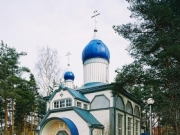

100 years Refugee Hellenism
The gardens of the Byzantine MuseumAthens Culture Net Find us on Facebook
Find us on youtube
Find us on instagram
Byzantine and Christian Museum :: Temporary exhibitions .::. Previous exhibitions
Estonia has always been a borderland on Europe’s religious landscape. To the east of the country lies the Orthodox world; in the other directions the Western church has always held sway. Orthodox Christianity has never been the dominant religion in these parts, but at different times and in different places it has nevertheless played a significant role – primarily for the Russians who have lived here, but also for Estonians, and in particular Estonians residing in the easternmost parts of the country.
The Byzantine Orthodox faith is known to have reached Estonia by the 11th century. There were Orthodox churches in both Tartu and Tallinn in the 14th century, and further houses of worship were to be found along the Russian border and in what is now the Viru counties in the 16th century. The Russian population in today’s Ida-Viru County has a long history, and the Orthodox Church took a hold there very early on. By the 16th century, Narva River had become a natural border between the Orthodox and Roman Catholic worlds, although Orthodox Russians (and at least some Votic Orthodox converts) also lived on the western side of the river.
Under imperial dictate, Orthodox Christianity was established throughout Estonia in the 19th century. It found the most fertile ground on the islands, but Orthodox churches and chapels with onion domes were erected in all parts of the country. This means that Orthodox architectural heritage can be found today in both urban areas and the countryside, with some examples being of great importance. True, not all of these churches have the congregations to support them, and many in fact lie in ruins. The evanescence of religious space, however, is a sacral experience in itself.
The exhibition gives an overview of the history of Orthodoxy and Orthdox sacral architecture in Estonia. Orthodox churches with their cupolas can be found in unexpected places in Estonia. They are often situated far from the villages or settlements, standing alone, but well observable from a passing road. They seem more natural and integral in regions of Estonia where Orthodoxy was more dominant, where they are also better kept and maintained (Eastern Estonia); at the same time, scores of sacral buildings lay more or less in ruins. Orthodox churches are in particularly bad shape. They are often surrounded by uncontrolled thickets, forgotten by the community and minded only by some lone enthusiasts of history and architecture. As a counterpoise, we can see several shining and sparkling town churches. Bright colours, gilded iconostases and frankincense create the right atmosphere, drawing in both townspeople and tourists. This is the presentable side of Orthodoxy in traditionally lutheran Estonia.
GENERAL COORDINATION
dr Katerina P. Dellaporta
Director of the Byzantine and Christian Museum
Texts
Jaanus Plaat, Leele Välja
Photos
Arne Maasik
Design
Marge Pervik-Kaal
General Supervisor - Translation
dr Antonis Bekiaris, archaeologist (BCM)
Museographic design
Spyros Nasainas, architect
Graphic design
Yannis Stavrinos / Yorgos Soupios
Supported by Museum of Estonian Architecture, Estonian Cultural Endowment, Estonian Academy of Arts, Estonian Ministry of Foreign Affairs, the Estonian Embassy in Athens and Byzantine & Christian Museum.
















